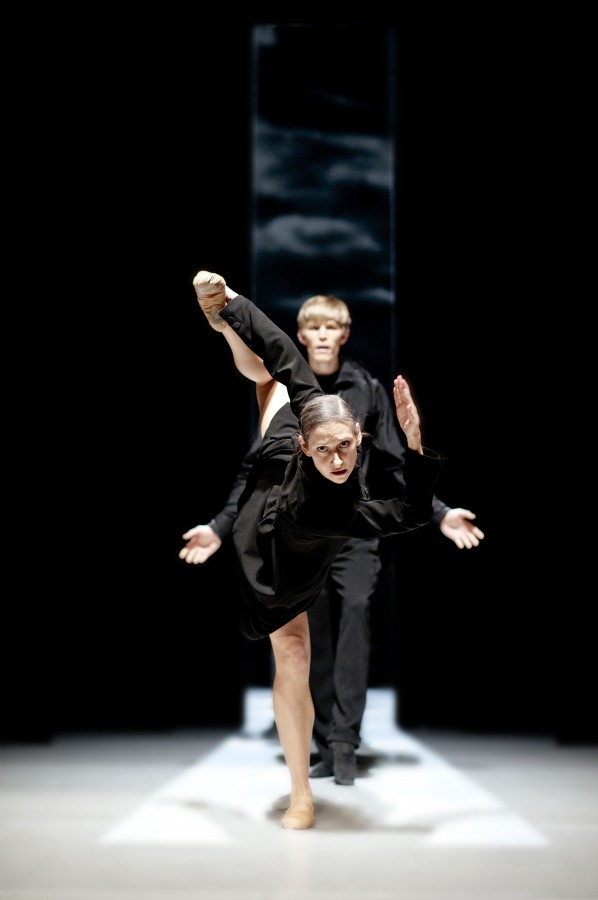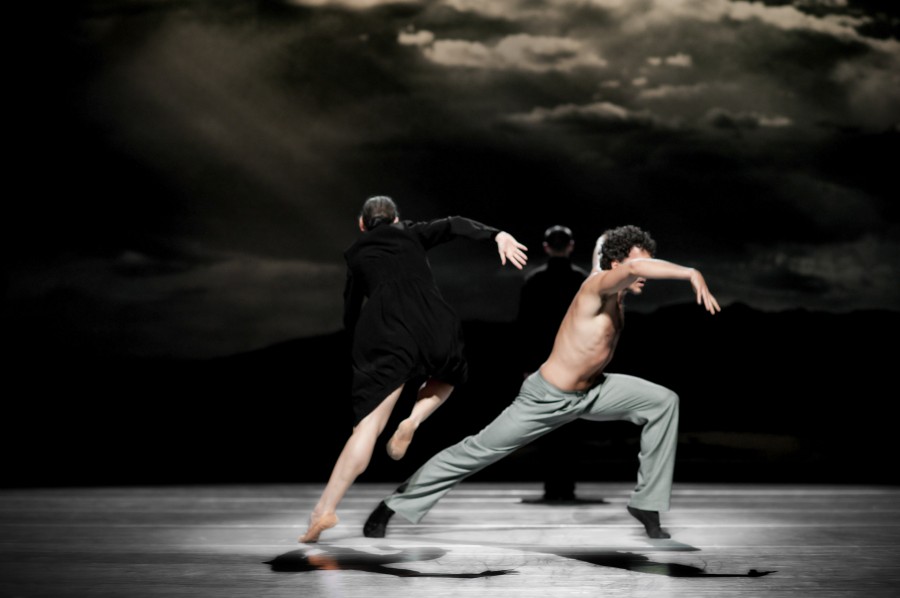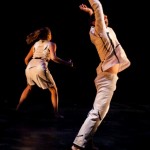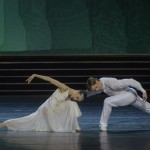Leigh Donlan reports from Zellerbach Hall in Berkeley:

Company members of Nederlands Dans Theater in Lightfoot and Leon’s SCHMETTERLING (Photo courtesy Nederlands Dans Theater)
It was a much anticipated return. Nederlands Dans Theater at Cal Performances in U.C. Berkeley’s Zellerbach Hall gave us two West Coast premières, Sehnsucht and Schmetterling, both choreographed by Paul Lightfoot and Sol León. This pair has had enormous shoes to fill since Jirí Kylián stepped down as artistic director, a position he held for over twenty years, the creator of a distinct dance aesthetic that is synonymous with NDT, a mix of balletic grace and bold modernism. I expected a new style of choreography from Lightfoot and León, and that is what we got.
Sehnsucht opened the evening’s program, a German term for ‘yearning’ or ‘longing,’ with music from various movements of Beethoven’s Piano Concerto No.3 in C Minor, Symphony No. 5 in C Minor, and Piano Concerto No. 4 in G Major. Minimal and massive, the setting was quintessential NDT. Silas Henriksen crouched alone in a spotlight, in loose white pants against a vast black background. Slowly, the stage was lit to reveal a suspended cube, containing a pair of lovers, Parvaneh Scharafali and Medhi Walerski, who appeared to be in conflict within this very confined room. It seemed like the solitary man outside this box had the better deal, free from any attachment. The room would spin in 90-degree increments forcing the couple to constantly readjust their positions. At one point the male (Walerski) leaves the room and joins an ensemble of dancers onstage, who are all dressed identically to him, in only loose black pants, including the women. I had to wonder what the point was to their toplessness. Was it simply for visual uniformity? But as the ensemble sequence began, the flying breasts didn’t matter. When this company moves together, it is powerful. They are some of best dancers in the world. But then the ensemble broke up, and we were back to solos, pas de deux, trois and quatres, in which the movement was as oppressive as the cube: arrested extensions, spasms and twitches, and many, many (of what appeared to be a new signature move) legs in attitude held in a high second position. An inescapable anxiety overtook the dancers. The majority of the audience was on the edge of their seats, though the woman next to me had started to doze off.
The final section of the piece came to a close as Walerski returned to the cube to find the woman even more irritated with him. She eventually climbs out a window and vanishes, he leaves through a door, and Henriksen returns to his crouch in the spotlight. The cube, perhaps the most intriguing character, was eventually blackened out. I could feel the audience start to breathe again. As the house lights came up for intermission, Henriksen remained on stage wandering slowly for what seemed an eternity (about ten minutes) staring blankly out into the theater (another signature move of the evening). Most of the audience took advantage of this bathroom break, but many stuck around to see if he’d have a psychological breakthrough, crack a smile, show any sign of emotion. He did not. Most of the audience enjoyed the suspense, applauding Henriksen when he simply stood up. It was a little disturbing to me, like he was a monkey in a zoo. We felt sorry for him and wanted to make things easier for him. But he was oblivious to us. He didn’t want our bananas, our ridiculous applause. Or did he? It seems evident that NDT is going in a different direction artistically now – more theater than dance.

Company members of Nederlands Dans Theater in SCHMETTERLING (Photo courtesy Nederlands Dans Theater)
Schmetterling was more of the same, anxious and twitchy. Five ominous, cascading black doorways occupied center stage. We saw heavy fog and heard the sound of rain. Dancer Ema Yuasa hobbled around, her skin and hair chalked white. She appeared to be an old woman suffering from dementia. The gallant Walerski was again the central male character, who was continually trying to keep this aging woman alive, afoot and alert (this piece was dedicated to Walerski’s deceased mother). Coming and going through the doorways, the ensemble performed comical vignettes to the music of The Magnetic Fields, and we finally saw the dancing and acting skills of more company members. Most of the vignettes were lovers’ quarrels of sorts, with lyrics like “One kiss from me and you’ll see God” as a female dancer held an upside down split with a strategic, cynical spotlight on her crotch, and “And nothing matters when you’re dancing/ In tat or tatters you’re entrancing” as the ensemble descended into the orchestra pit making unison robotic gestures and beaming Cheshire grins. Schmetterling came to a close as the last doorway was removed to reveal the majestic skyline of Death Valley, with light breaking through storm clouds. The old woman stood alone, her face contorted as she stared into the light. Death is the only certainty, seemed to be the straightforward conclusion.
The audience leapt to their feet in a standing ovation. Was I the only one who thought something critical was missing like… dancing? It was a visually stunning production, but we could have spent a little less time admiring the cleverness and spectacle of these sets and more time watching this sizable company of 30 dancers actually dance. I only remember four or five dancers clearly, but I can tell you all about the floating cube.







Hey Leigh,
I thought there was a TON of dancing all evening! http://www.bachtrack.com/review-oct-2013-nederlands-dans-theater-berkeley-usa Though the dance was often overwhelmed by the extreme facial contortions, the groaning and moaning, and the twitchy gestures.
You’re right about the signature blank stare. I couldn’t figure out if it was meant to express hostility or defensiveness, or to comment on the vacuousness of modern society. Program notes tell us that these pieces were all about love, and memory, and loss. That had me puzzled.
I thought the intermission was possibly the most brilliant part of the evening. It dissolved the barrier between stage and reality, and felt relaxed and charming. Interesting how the same episode can trigger opposing reactions.
I’m not even going to touch the “What is dance?” topic, but as a dancer, I empathize with the cast. Maybe they enjoyed the shock therapy choreography. But I suspect that some just needed a paycheck. I understand Lightfoot and Leon’s artistic vision, and I don’t disagree with it, but they used sets to shirk some other very important responsibilities. I agree that they appeared to break down the fourth wall of theater during intermission, and if we had seen more of this in the first and second sections, I may have felt differently about the evening.
So how about those flying breasts?
The 64,000 Euro question – What is dance?
Maybe the evening didn’t succeed as pure dance, but it didn’t succeed as pure theater or something in-between either because, as you say, the structure wasn’t coherent.
And the elements that were meant to be provocative didn’t seem fueled by anything.
I think Pina Bausch succeeded (sometimes) with her wacky amalgam of dance, song, stray bits of dialogue, pedestrian movement, and aimless rituals because those elements were carefully curated and glued together with some magic substance that I can’t always name – sometimes it was her choice of music. In the case of Sensucht and Schmetterling, the choreography seemed to alternately ignore the music and beat it to a pulp.
As I wrote in my review for Bachtrack, I was okay with the flying breasts. But in this age of equality, if you’re going to take away the women’s supportive garments, to be fair you should strip the men of their dance belts 🙂